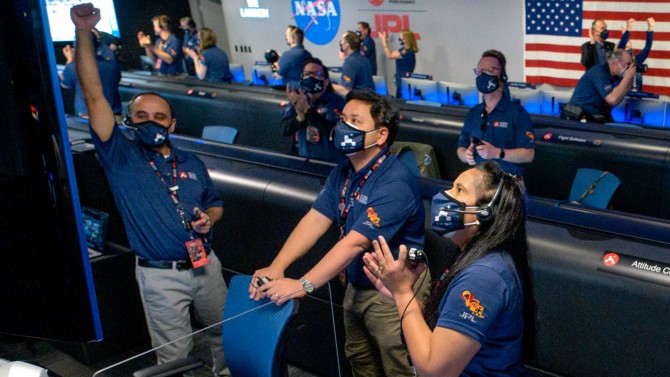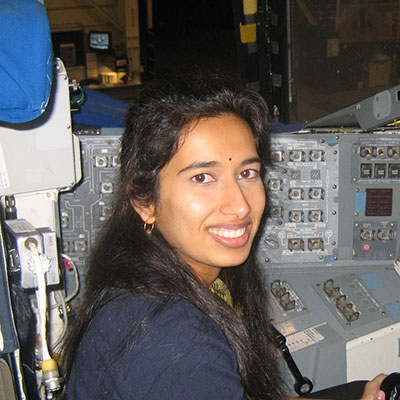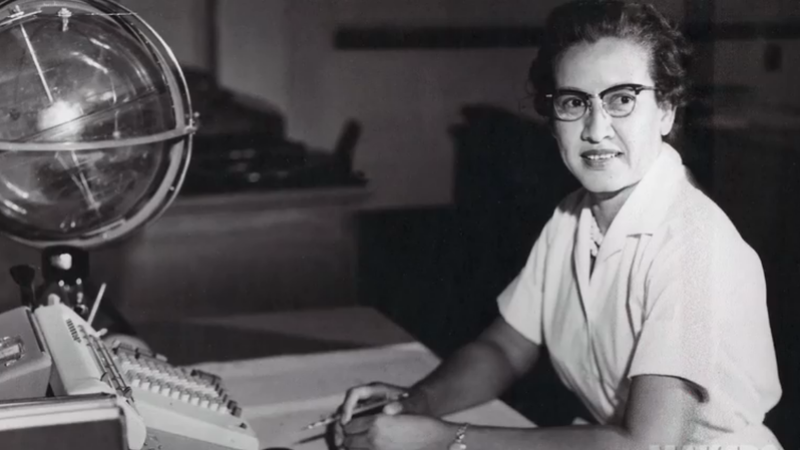
Full Orbit: From Science Fair to Mars Mission
Pictured above: Swati Mohan at NASA's Jet Propulsion Laboratory mission control. (Photo Courtesy of NASA/JPL)
Twenty-five years ago, Swati Mohan presented a science fair project on what it would be like to grow plants on Mars. Little did she know she would eventually be working as an aerospace engineer with NASA’s Jet Propulsion Lab (JPL). She was the Guidance and Controls Operations lead on the Mars 2020 mission working on the Perseverance Rover.
Mohan, who graduated from Hayfield in 2000, initially thought she wanted to be a doctor. Then she took physics in high school and was inspired by her teacher. He was an engineer by training, and the way he presented science was easy for Mohan to understand.
“It’s very basic, F=MA,” she says, referring to Newton’s second law of motion: force equals mass times acceleration. Newton’s laws of motion explain the movement of objects and systems. “That same equation takes you all the way through graduate school,” she says. “It’s just layer upon layer of using that same equation to explain the world around you.”
Mohan recently came across her high school science fair submissions. The first year she presented, she and her sister had shadowed an aunt who worked in a biotech lab. “I was so proud,” she says. Her project “sounded so fancy and advanced.” However, that project didn’t place, even at the school level.

The next year, she had a hard time coming up with a science fair topic. Eventually she settled on “Terraforming Mars” (growing plants on Mars). “This was way before movies or books like the Martian,” she is quick to point out.
She knew soil on Mars is rich in iron oxide, so she experimented with how different amounts of iron oxide would affect plant growth. This project was “way simpler” than the previous one, she thought. But she ended up placing at the local fair, going to the Regional Science Fair and earning an honorable mention.
Looking back, the second project “had a clear thesis,” she realizes. “I came up with it. So the ‘why’ was important to me.” She was able to walk science fair judges through the step-by-step process. “That’s what they were looking for,” she says. “It didn’t matter that the previous one sounded so cool if I didn’t really know about it.” Her Mars project “came from my actual passion and interest.”
Now as she looks back on that project, Mohan’s perspective allows her to see the start of a journey she didn’t even imagine in high school.
“That was my first experiment on Mars, and now we’re actually going to help bring the real dirt [from Mars] back to Earth,” she says. “I look back on it now and it’s pretty cool, because when you’re that age, you can’t see the connections between interest and careers. Having the positive reinforcement that when I chose my own question based on my interest and put in the hard work; that’s when it paid off.”
Inspired by Women

Mohan fondly remembers her high school history teacher. In addition to teaching, she was on the advanced placement board or going to other professional development conferences. Mohan was struck by how she had a plan and was moving forward in her career; and worked to “make a difference not just in her individual class, but broadly across the discipline,” she says.
She has also had many examples to look up to in STEM fields. Her mother and aunts have worked in STEM fields. And at NASA JPL, she’s learned from a lot of female “rock stars.” Among them are Mimi Aung, the project manager of the Ingenuity Helicopter, and Jennifer Trosper, who has led multiple Mars missions.
“It’s really amazing to watch them in meetings; the technical ownership they have over their area and how they’re able to hold their own in such a male dominated field,” Mohan says.
Advice for Young Women
Mohan encourages young women to follow three pieces of advice to find and succeed at their passions.
First, really know yourself, what you’re interested in, and what your strengths and weaknesses are.
Then, “create a really good support system,” she says. “This is a combination of friends, family, mentors and advisers; people who will support you throughout your journey, who will encourage you and help you keep reaching for more. That serves as a foundation you can rely upon.”
Finally, actively do your best. Everyone has their own path, and not every opportunity or door is clearly marked. “Sometimes you have to build the door yourself,” she says. “Do your research, have the confidence to ask for things and volunteer for things, even though you might not be fully ready. Without asking [for help], it’s really hard to make progress.”
Now, when she looks back on her science fair project about terraforming Mars, she can see that she took her own advice of “know yourself.”
“Know what your interests are—not what other people say they are or what you think they should be. Leverage that with your skills and find your own path,” she says. “That’s when true success will start to build.”
In this video, Mohan provides the play-by-play of the Perseverance rover landing. (Courtesy of NASA/JPL)








